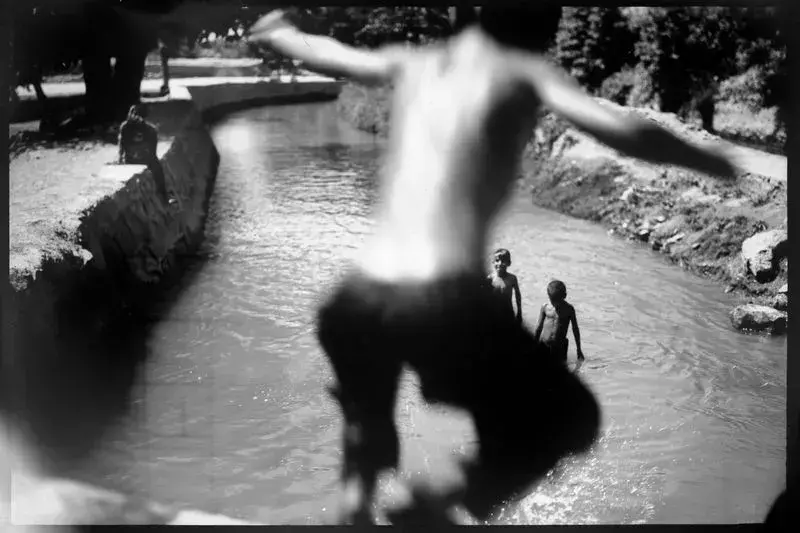
The curious-looking device resembles little more than a large black box on a tripod. Known as a kamra-e-faoree, or instant camera, it’s a handmade wooden camera and darkroom in one. They were a common sight on Afghan city streets in the last century — a fast and easy way to make portraits, especially for identity documents. Simple, cheap and portable, they endured through half a century of dramatic changes in this country — from a monarchy to a communist takeover, from foreign invasions to insurgencies — until 21st-century digital technology rendered them obsolete.

Using this nearly disappeared homegrown art form to document life in post-war Afghanistan over the course of a month produced hundreds of black-and-white prints that reveal a complex and sometimes contradictory narrative. The old technology imparts a vintage, timeless quality to the images, as if the country’s past is superimposed over its present — which in many respects, it is.
The portrait of life that emerges two years after U.S. forces left and the Taliban returned to power is dramatically different for many Afghans, especially those who worked with the previous government or military, urban professionals and women and girls. For others, including the very poor and Afghans in remote rural areas, little has changed over the decades, regardless of who was in charge.

As a nonprofit journalism organization, we depend on your support to fund more than 170 reporting projects every year on critical global and local issues. Donate any amount today to become a Pulitzer Center Champion and receive exclusive benefits!
During their first stint in power from 1996 to 2001, the Taliban banned photography of humans and animals as contrary to the teachings of Islam. Many box cameras were smashed, even as some were quietly tolerated, Afghan photographers say. But it was the advent of the digital age that sounded the device’s death knell.
“These things are gone,” says Lutfullah Habibzadeh, 72, a former kamra-e-faoree photographer in Kabul. “Digital cameras are on the market, and [the old ones] are out of use.” Habibzadeh still has his old box camera, a relic of the last century passed down to him by his photographer father. It no longer works, but he has lovingly preserved its red leather coating, decorated with sample photos.
On Afghan city streets today, billboard advertisements have faces spray-painted out, and clothing store windows display mannequins with their heads wrapped in black plastic bags, to adhere to the renewed ban on the depiction of faces.
But the advent of the internet age and of smartphones have made a total ban on photography impossible to enforce. The novel sight of an old box camera elicits excitement and curiosity — even among those who police the new rules. From foot soldiers to high-ranking officials, many Taliban were happy to pose for box camera portraits.
Outside a warehouse in Kabul, a group of men watch intently as the camera is set up. At first, they seem shy. But as the first portraits emerge, curiosity overtakes their reservations. Soon, they’re smiling and joking as they wait to have their photos taken, pitching in to help when a black cloth backdrop slips off the wall. As each man steps forward for his portrait, set jaws replace tentative smiles. Adjusting their grip on their assault rifles, they look straight into the camera’s tiny lens and hold their poses.
Most of these men joined the Taliban as teenagers or in their early 20s and have known nothing but war. They were drawn to the fundamentalist movement because of their fervent Muslim faith — and their determination to expel the U.S. and NATO troops who invaded their country and propped up two decades of Afghan governments that failed to crack down on rampant corruption and crime.


Peace, at a Price
Two years after the Taliban swept through the country to seize power again, there are strong echoes of life as it was before U.S.-led NATO forces toppled them from government in 2001.
Once more, the country is ruled by a fundamentalist movement that has restored many of the strict rules it imposed in the 1990s. The first Taliban regime was notorious for destroying art and cultural patrimony it deemed un-Islamic, including the giant ancient buddhas carved into cliffs in Bamiyan. They imposed brutal punishments, chopping off hands of thieves, hanging supposed blasphemers in public squares and stoning women accused of adultery.
Once again, executions and lashings are back. Music, movies, dancing and performances are banned, and women are again excluded from nearly all public life, including education and all but a few professions.

The return to hardline policies has chased away Western donors, aid workers and trade partners. Poverty has spiraled to crisis levels, fueled by the ban on women working, deep cuts in foreign aid and international sanctions. But there is nearly universal relief that the relentless bloodshed of the past four decades of invasions, multiple insurgencies and civil war has largely ceased.
There are still sporadic bombings, most attributed to another extremist movement, enemies of the Taliban known as the Islamic State-Khorasan Province, or IS-K. But Afghans interviewed say their country is more peaceful than they’ve known for decades. Even those who dislike the current regime say banditry, kidnapping and corruption, which were rampant under the previous governments, have been largely reined in.
Even so, less crime and violence does not necessarily translate to prosperity and happiness.














